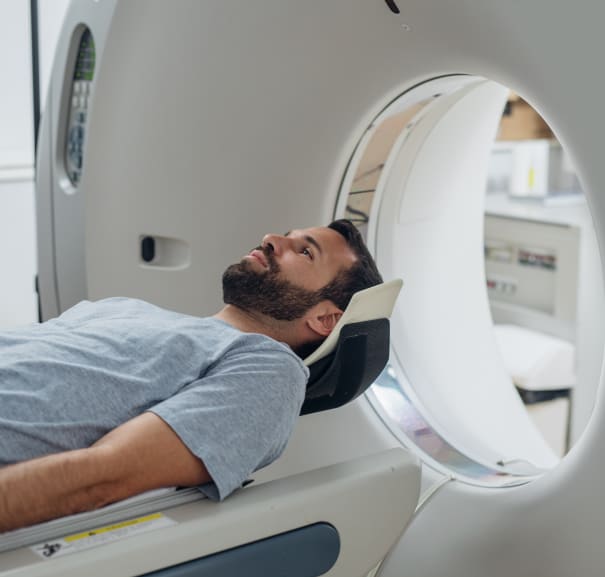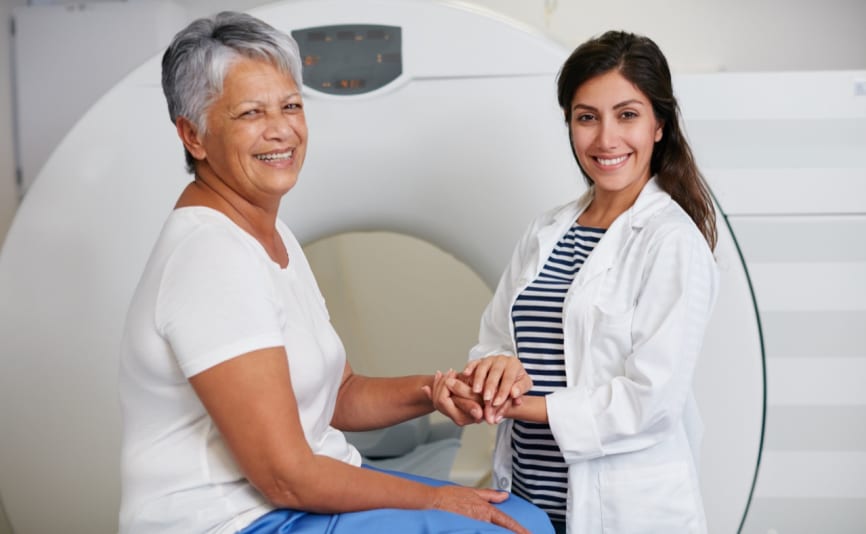Facial CT Scan: Information & Get a Scan
If you’re suffering from headaches or dizziness, or have been experiencing seizures, a CT scan of your facial bones can examine the causes of pain or discomfort in the face and head area. CT can also be used to examine the nasal bones and septum for any abnormalities.
CT Facial bones: anatomy and what a CT scan of the face shows
The facial skeleton consists of 14 bones. The skull is far more complex than just a single bone, and the small bones of the face can be prone to fractures, malformations and breaks.
The facial bone anatomy consists of:
-
Nasal bones (x2) - a pair of bones that form the bridge of your nose
-
Palatine bone (x2) - a pair of bones that make up some of the nasal cavity and palate
-
Lacrimal bone (x2) - a pair of bones in your eye socket, close to the inner corner of your eye
-
Zygomatic bone (x2) - cheekbones
-
Maxillary bones (x2) - the bones that form your upper jaw
-
Inferior nasal conchae (x2) - a spongy pair of bones in the nasal cavity that help filter and warm up the air we breathe
-
1 vomer bone - a thin bone that divides the nasal cavity into left and right
-
1 mandible - lower jaw bone, and the largest bone of the skull
The facial skeleton supports the eyes, nasal and oral cavities (nose and mouth), jaw, and the overall structure of your face. The anatomy also includes soft tissues such as the facial muscles, nerves, and ligaments.
CT scans of the facial bones usually focus on imaging the jaw, eye sockets, cheekbones and nose, including the nasal bones, nasal septum and nasal cavity. They can be used to help doctors and medical professionals diagnose fractures, trauma, and any malformations.
Some facial CT scans also capture information about the sinuses, which can identify conditions such as sinusitis or a deviated septum. For a specific CT scan of the paranasal sinuses, please book the specific option on our website.
The temporal bone is a separate bone at the sides of the base of your skull, and a different temporal bone CT scan is available focussed solely on diagnoses of problems in this area.
What can CT scans of the facial bones diagnose?
The images of your facial bones gathered from a CT scan can provide insights into:
-
Joint problems, for example temporomandibular joint (TMJ) disorder, which can cause pain when you chew and talk. The TMJ is the joint linking your bottom jaw to your skull
-
Facial fractures or broken bones, such as a fractured cheekbone or broken nose
-
Any trauma to the bones of the face
-
Other abnormalities, such as tumours or masses
-
Malformed bones that may have been present since birth (congenital malformations)
What are the different types of facial fractures and classifications?
Facial fractures can happen in accidents like trips or falls, in certain sports, or as a result of violence. Your facial bones are fairly thin, so injuries like fractures can be common in these circumstances.
The most common facial fractures include the nose, forehead (frontal bone), eye socket, cheekbones, upper jaw, or a combination of the latter three also known as a tripod facial fracture. A broken or fractured jaw is also common.
A Le Fort fracture is a complex fracture in the middle of your face, usually along areas that are structurally weaker.
Are CT scans of the facial bones safe?
CT scans use ionising radiation, whereas ultrasound and MRI scans do not. To protect you from unnecessary radiation exposure, our in-house clinical experts will provide a 1-1 consultation call once you’ve placed your booking. They’ll discuss your symptoms, and make sure you've chosen the right scan for your needs. In some cases, an MRI might be more suitable, and your clinician will be able to help you select a different type of imaging procedure.
What happens during a CT scan?
CT scan procedures are usually quick and straightforward. The CT scanner itself is shaped like a doughnut, with a flat motorised bed that moves in and out of the space in the middle of the machine. Usually, you’ll be asked to lie down for your scan, and the part of the body that is being scanned will be positioned in the centre of the scanner (in this case, your head).
During the scan, X-ray beams will circle around your body, and a detector on the opposite side of the scanner will record the strength of the rays passing through your bodily tissues. This data is computed to create images of different structures within your body. CT scans are more detailed than the standard X-ray scans you might have for a broken bone.
CT scan images are created in ‘slices’, which can then be compiled into 3D images. Your consultant can also view the results as a series of 2D images, to help them pinpoint exactly where any abnormalities might be.
How long does a facial CT scan take?
CT scans are one of the fastest diagnostic imaging procedures, and can be completed in under a minute. Despite this, your appointment time can vary depending on the body part being scanned, and whether you need a contrast agent injection, to get changed beforehand, or to fill in any paperwork. Our appointments usually last up to 30 minutes.
How do you prepare for a face CT scan?
We recommend arriving at your selected scanning centre 15 minutes before your appointment is due to start. This is so that you can be seen on time, and allows time to complete any forms or paperwork needed.
CT scans of the facial bones don’t require much preparation, but you will be asked to remove earrings and facial piercings, and in some cases, hearing aids. This is because metal objects can interfere with the quality of CT scan images. They can cause blurring or anomalies in the images, also known as artifacts.
Depending on what you wear to your scan, you might be required to change into a medical gown. Usually this isn't necessary for a CT scan of the face or head, as only the part of the body being scanned enters the scanner.
Of course, we'll always let you know ahead of your appointment if there are any specific preparations you need to make. Our clinical team will also assess whether a contrast agent is needed for the type of scan you’re having, and tell you if there’s anything you need to do before your scan. For CT scans, an iodine-based contrast agent is often used to improve the definition of your scan images.
How much does a facial bones CT scan cost?
Our CT scan prices start from £359. The price you pay upfront covers a complete package of care, which includes:
-
A pre-scan consultation with a dedicated expert clinician, to discuss your symptoms and requirements, and make sure a CT scan is appropriate
-
A fast referral to your chosen scanning centre, with no GP visits and no waiting lists
-
Your scan, at a convenient location near you
-
A radiologist’s report of your results
-
Access to your scan images upon request
-
A post-scan consultation with your clinician if any next steps are required
Next steps:
-
Book a private CT scan today, to fast-track your diagnosis and route to treatment
Sources used:
https://www.cedars-sinai.org/programs/imaging-center/exams/ct-scans/facial-bones.html
https://myhealth.alberta.ca/Health/Pages/conditions.aspx?hwid=hw209926


